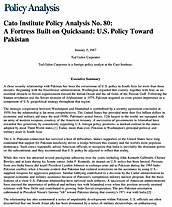The strategic cooperation between Washington and Islamabad is symbolized by a security agreement concluded in 1959, but the relationship is far more comprehensive. The United States has provided more than five billion dollars in economic and military aid since the mid-1950s. Pakistan’s armed forces, 12th largest in the world, are equipped with an array of modern weapons, courtesy of the American treasury. A succession of governments in Islamabad have rewarded this generosity by consistently supporting U.S. foreign policy positions–a marked contrast to the stance adopted by most Third World states.[1] Today, more than ever, Pakistan is Washington’s principal political and military asset in South Asia.
The U.S.-Pakistan connection has survived a host of difficulties. India’s supporters in the United States have long contended that support for Pakistan needlessly drives a wedge between this country and the world’s most populous democracy. Such critics repeatedly advise American officials to recognize that India is inevitably the dominant power on the subcontinent, and they recommend that U.S. policy be adjusted to reflect that reality.
While this view has attracted several prestigious adherents over the years, including John Kenneth Galbraith, Chester Bowles, and at least during his Senate career, John F. Kennedy, its impact on U.S. policy has been limited. Pressure from pro-India forces did impel President Lyndon Johnson to embargo arms aid to Pakistan during the 1965 Indo-Pakistan conflict, when it became evident that Pakistan had violated restrictions on the assistance by using U.S.-supplied weapons for aggressive purposes. Similar lobbying contributed to a decision by the Carter administration to suspend economic and military assistance because of Pakistan’s surreptitious military nuclear program. But the basic features of a close U.S.-Pakistan relationship have survived such setbacks. A succession of American administrations have stressed the importance of political and military ties with Islamabad even when this position severely strained relations with New Delhi and contributed to growing Indo-Soviet cooperation. The pro-Pakistan orientation culminated in President Nixon’s famous “tilt” toward Pakistan during that country’s 1971 war with India.[2]
The relationship has also surmounted a series of unpalatable developments within Pakistan. U.S. officials are often discomfited that our South Asian ally has been dominated by a series of military dictatorships, an embarrassing contrast to India’s history. Civilian rule has accounted for barely one third of Pakistan’s four decades of independence. The current government of President Mohammad Zia ul-Haq dates from a military coup in 1977. Moreover, these dictatorial regimes have amassed a distressing record of human rights violations.[3]
Endemic political instability in Pakistan has also strained the relationship with Washington. The 1971 “tilt” occurred in the aftermath of a bloody civil war in which East Pakistan broke away to form the new nation of Bangladesh. During the mid-1970s, the government in Islamabad fought a lengthy and difficult campaign to suppress another separatist movement in Baluchistan province. Other secessionist impulses, while less potent, have surfaced repeatedly throughout the country’s troubled history.
A continuing source of alarm for the United States is Pakistan’s apparent determination to develop a military nuclear capability to match a similar program in India. Not only does this strategy undermine Washington’s long-standing effort to prevent the proliferation of nuclear weapons, it creates undesirable risks for the United States. American policymakers exhibit understandable uneasiness about Pakistan obtaining nuclear armaments given that country’s exceedingly stormy relationship with India.[4]
Such ominous developments should have caused U.S. policymakers to reassess the wisdom of investing so much diplomatic, political, and military capital in an unpredictable and unstable ally. For a brief period during the early years of the Carter administration there was some evidence of a reevaluation, but any inclination to deemphasize the Pakistan connection vanished when Soviet troops invaded Afghanistan. The Carter administration promptly muted its criticism of the Zia regime’s human rights record, reiterated the 1959 security guarantee, and offered a new package of military aid totaling some $400 million.[5]
During the intervening years, Pakistan has resumed its traditional role as America’s principal political and military outpost in South Asia. Congress authorized a $3.2 billion five-year aid package in 1981, and the Reagan administration has requested a new program exceeding $4 billion when the original measure expires at the end of FY 1987.[6] In exchange, Washington has pressured the Zia government to serve as a conduit for covert U.S. military aid to Afghan rebel forces, the mujaheddin, fighting the Soviet occupation army. That assistance is now estimated at $250-$300 million annually.[7]
The direct aid to Pakistan (which has included F‑16 fighters and other sophisticated weapons in the American arsenal normally not available to Third World allies) combined with Islamabad’s heightened role in the Afghanistan conflict underscores how much the United States has invested in its South Asian policy. Evidence suggests, however, that it is a risky and unwise commitment.
Washington views Pakistan both as a bulwark in its own right against Soviet expansion and as an important component of American policy toward Afghanistan. But Pakistan is an extraordinarily frail ally–an impoverished nation with a history of political separatism and instability, governed precariously by a military strongman who faces mounting domestic opposition. The last point was underscored in April 1986 when massive anti-government crowds greeted the return from exile of Benazir Bhutto, daughter of the country’s last elected prime minister and heir to his political machine. Pakistan seems destined for yet another period of acrimonious confrontation and domestic turmoil. By placing so much reliance on a weak and unstable ally, the United States risks the collapse of its entire South Asian policy.


